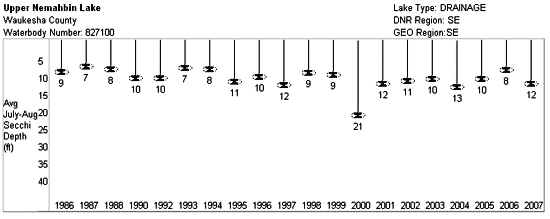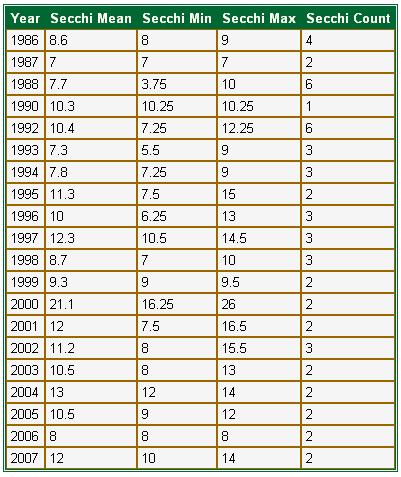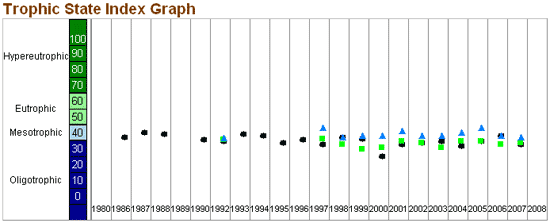Learn About
Closest Town: Delafield
Lake Size: 283 Acres
Public Boat Access: West side of channel between Upper and Lower Nemahbin Lakes operated by Wauksha County.
Lake Notes: Specializing in Bluegill, Large & Smallmouth Bass. Walleye, Northern Pike and Crappie also caught. Connects to Lower Neshotah & Lower Nemahbin Lake.
| Size: (total) | ||
| Surface Area (Acres) | 283 | |
| Volume (Acre-Feet) | 8,377 | |
| Direct Tributary Drainage Area (Acres) | 1,734 | See Map 1* |
| Total Tribuatary Drainage Area (Acres) | 25,585 | See Map 3* |
| * Upper Nemahbin Lake Watershed Inventory Findings, Southeastern Wisconsin Regional Planning Commission May 1995 | ||
| Shape: | |
| Maximum Length (Miles) | 1.1 |
| Length of Shoreline (Miles) | 2.9 |
| Maximum Width (Miles) | 0.6 |
| Depth: | |
| Maximum (feet) | 60 |
| Mean Depth (Feet) | 29.6 |
Upper Nemahbin Lake Trends Over Time
Upper Nemahbin Lake Drainage Graph: Secchi Disk Measurments

Graph From the Wisconsin Department of Natural Resources
Secchi Averages for July and August 1986-2007

Data Taken From Wisconsin Department of Natural Resources
Upper Nemahbin Lake Trophic State Index (TSI) Graph

| TSI(Chl) = TSI(TP) = TSI(Sec) | It is likely that algae dominate light attenuation. |
| TSI(Chl) > TSI(Sec) | Large particulates, such as Aphanizomenon flakes dominate |
| TSI(TP) = TSI(Sec) > TSI(Chl) | Non-algal particulate or color dominate light attenuation |
| TSI(Sec) = TSI(Chl) >= TSI(TP) | The algae biomass in your lake is limited by phosphorus |
| TSI(TP) > TSI(Chl) = TSI(Sec) | Zooplankton grazing, nitrogen, or some factor other than phosphorus is limiting algae biomass |
| TSI | TSI Description |
|---|---|
| TSI < 30 | Classical oligotrophy: clear water, many algal species, oxygen throughout the year in bottom water, cold water, oxygen-sensitive fish species in deep lakes. Excellent water quality. |
| TSI 30-40 | Deeper lakes still oligotrophic, but bottom water of some shallower lakes will become oxygen-depleted during the summer. |
| TSI 40-50 | Water moderately clear, but increasing chance of low dissolved oxygen in deep water during the summer. |
| TSI 50-60 | Lakes becoming eutrophic: decreased clarity, fewer algal species, oxygen-depleted bottom waters during the summer, plant overgrowth evident, warm-water fisheries (pike, perch, bass, etc.) only. |
| TSI 60-70 | Blue-green algae become dominant and algal scums are possible, extensive plant overgrowth problems possible. |
| TSI 70-80 | Becoming very eutrophic. Heavy algal blooms possible throughout summer, dense plant beds, but extent limited by light penetration (blue-green algae block sunlight). |
| TSI > 80 | Algal scums, summer fishkills, few plants, rough fish dominant. Very poor water quality. |
Trophic state index (TSI) is determined using a mathematical formula (Wisconsin has its own version). The TSI is a score from 0 to 110, with lakes that are less fertile having a low TSI. We base the overall TSI on the Chlorophyll TSI when we have Chlorophyll data. If we don't have chemistry data, we use TSI Secchi. We do this rather than averaging, because the TSI is used to predict biomass. This makes chlorophyll the best indicator.
Report Taken From: Wisconsin Department of Natural Resources
Aquatic Plants Found in Upper Nemahbin Lake |
|
 |
|
 |
|
 |
|
 |
|
 |
|
 |
|
 |
|
 |
|
 |
|
 |
|
 |
|
 |
|
 |
Ranunculaceae |
